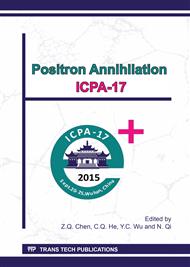p.171
p.179
p.183
p.189
p.193
p.197
p.201
p.205
p.209
Study of Defects in High Energy Ion Implanted ZnO Crystals
Abstract:
Positron annihilation spectroscopy (PAS) was employed for characterization of defects in the hydrothermally (HT) grown zinc oxide single crystals irradiated by high energy ions. Defects created in ZnO crystals by 2.5 MeV protons, 7.5 MeV N3+ and 167 MeV Xe26+ ions were compared. The virgin ZnO crystals contain Zn-vacancies associated with hydrogen. Ion implantation introduced additional defects, namely Zn+O di-vacancies in crystals irradiated by protons and small vacancy clusters in samples implanted by N and Xe ions.
Info:
Periodical:
Pages:
193-196
Citation:
Online since:
March 2017
Keywords:
Price:
Сopyright:
© 2016 Trans Tech Publications Ltd. All Rights Reserved
Share:
Citation:


